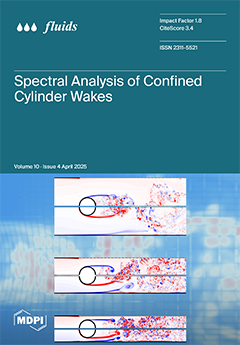The process of ultrasonic atomization involves a series of dynamic/topological deformations of free surface, though not always, of a bulk liquid (initially) below the air. This study focuses on such dynamic interfacial alterations realized by changing some acousto-related operating conditions, including ultrasound excitation
[...] Read more.
The process of ultrasonic atomization involves a series of dynamic/topological deformations of free surface, though not always, of a bulk liquid (initially) below the air. This study focuses on such dynamic interfacial alterations realized by changing some acousto-related operating conditions, including ultrasound excitation frequency, acoustic strength or input power density, and the presence/absence of a “stabilizing” nozzle. High-speed, high-resolution imaging made it possible to qualitatively identify
four representative transitions/demarcations: (1) the
onset of a protrusion on otherwise flat free surface; (2) the
appearance of undulation along the growing protuberance; (3) the
triggering of emanating beads fountain out of this foundation-like region; and (4) the
induction of droplets bursting and/or mist spreading. Quantitatively examined were the two-parameters specifications—on the degrees as well as induction—of the periodicity in the protrusion-surface and beads-fountain oscillations, detected over wider ranges of driving/excitation frequency (0.43–3.0 MHz) and input power density (0.5–10 W/
) applied to the ultrasound transducer of flat surface on which the nozzle was either mounted or not. The resulting time sequence of images processed for the extended operating ranges, regarding the fountain structure pertaining, in particular, to recurring beads, confirms the wave-associated nature, i.e., their size “scalability” to the ultrasound wavelength, predictable from the traveling wave relationship. The thresholds in acoustic conditions for each of the four transition states of the fountain structure have been identified—notably, the onset of plausible “bifurcation” in the chain-beads’ diameter below a critical excitation frequency.
Full article





